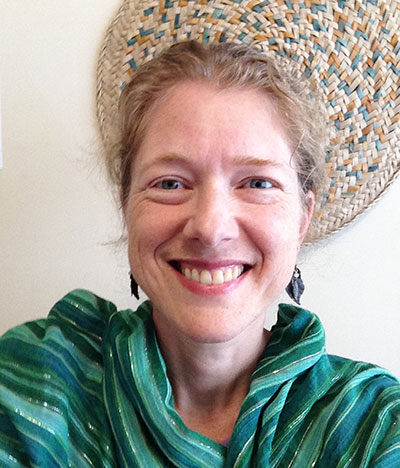Apologies, but no results were found.
Angela Andersen
Sessional Lecturer
Creative Studies
Office: Teaching remotelyEmail: angela.andersen@ubc.ca

Research Summary
Art and architecture of the Islamic world; vernacular and quotidian architecture; minority and marginalized Islamic communities; inter- and intra-religious interactions; architecture, art and human rights; oral history theory and collection
Courses & Teaching
ART 203: Global Contemporary Art
Biography
Angela Andersen has worked as a museum professional, a university instructor in Canada and the United States, and in various aspects of academic publishing. Her recent research and teaching examines the art, architecture and practices of Muslim minorities, including the human rights issues faced by the Alevis of Turkey regarding the sites of worship and the Islamic architecture of what is now Turkey and its surrounding states. Her oral history-based research and site studies have appeared in a number of international publications, and she is currently serving as the guest editor for a special issue of the International Journal of Islamic Architecture on hinterland forces and marginalisation (forthcoming 2022).
Degrees
BA an MA (University of Victoria); PhD (The Ohio State University); Postdoc (MIT)
Selected Publications & Presentations
(editor) Islamic Architectures: Muslim Spaces of Prayer, Ceremony and Learning Beyond the Mosque (Intellect, forthcoming 2022).
(guest editor) International Journal of Islamic Architecture 11.2 Special Issue: ‘Hinterland Forces: Architectural Responses at the Margins’ (forthcoming 2022)
‘The Anecdotal Archive: Building Design, Oral History, and the Notion of An Alevi Place of Worship,’ International Journal of Islamic Architecture 11.1 (forthcoming 2021).
‘The Tale of the Shared Church in Diyarbakir: Narrative Traditions of the Co-Use of Places of Prayer by Muslims and Christians,’ in Articles of Faith: Visual Culture in the Byzantine and Islamic Worlds, ed. Eva Baboula and Lesley Jessop (Leiden: Brill, 2021), 175–204.
‘“He who is the wondrous green dome is ‘Ali:” The Relationship Between Narratives of the Prophet Muhammad’s Ascension and the Communal Religious Architecture of The Alevis,’ in Saintly Spheres and Islamic Landscapes, ed. Daphna Ephrat, Sara Ethel Wolper, and Paulo G. Pinto (Leiden: Brill, 2020), 301–34.
‘”A Tenacious Reputation for Unreliability:” Re-Viewing Evliya Çelebi’s Description of the Diyarbakir Ulu Cami in the Seyahatname,’ Architecture and Culture 8.1 (2020): 29–53.
(with Can Gündüz), ‘Sweeping the Meydan: Home and Religious Ceremony Amongst the Alevis’, RACAR, Special Issue: Approaching Home: New Perspectives on the Domestic Interior 45.2 (2020): 48–64.
‘One House of Worship With Many Roofs: The Attempted Imposition of Architecture to Mediate Mainstream Sunni, Alevi and Gülenist Islam in Turkey, International Journal of Islamic Architecture 8.2, Special Issue: Boundaries, Flows, and the Construction of Muslim Selves through Architecture (2019): 283–305.
‘The Transfer of Turkish Bektashi Tekkes to Alevi Cemevleri,’ in 15th International Congress of Turkish Art, Naples, Università di Napoli “L’Orientale” 16-18 September 2015, ed. Michele Bernardini, Alessandro Taddei, et al. (Ankara: Ministry of Culture and Tourism, Republic of Turkey), 109–21.
‘Architectural Metaphor in Sufi Philosophy: The Imagery of Celal al-Din Rumi,’ in ODTÜ Mimarlik Tarihi Kongresi/METU Architectural History Conference Proceedings, ed. Elvan Altan Ergut, Sevil Enginsoy Ekinci, and Ali Uzay Peker, (Ankara; Middle East Technical University Press), 71–82.
‘Muslims Viewed as “Non-Muslims:” The Alevi Precincts of Anatolia,’ in Sacred Precincts: Non-Muslim Sites in Islamic Societies, ed. Mohammad Gharipour (Leiden: Brill, 2015), 57–75.
Selected Grants & Awards
Centre for Studies in Religion and Society, University of Victoria, fellowship (2019–2021)
Massachusetts Institute of Technology/Aga Khan Program for Islamic Architecture (AKPIA@MIT), postdoctoral fellowship (2016–17)
The Margaret B. Ševčenko Prize in Islamic Art and Culture (2016)
Society of Architectural Historians Opler Membership Grant; Society of Architectural Historians Spiro Kostof Annual Fellowship; Social Sciences and Humanities Research Council of Canada Doctoral Fellowship; Hamad bin Khalifa Islamic Art Fellowship; Turkish Studies Association Halide Edip Adivar Scholarship; Turkish Cultural Foundation Research Fellowship